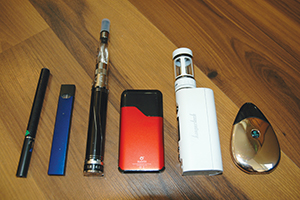By KEN LEISER
Several times a month, Cheryl Phillips talks to teens and parents about the rise of vaping among young people and what that means for their health — from nicotine's effect on developing brains to the chemicals in the vapor they inhale.
Phillips coordinates the St. Joseph Mercy Health Exploration Station, an interactive health education center for kids located at St. Joseph Mercy Canton health center in Canton, Mich. She said requests for her presentation — "Vaping 101: What's Important to Know" — began rolling in a couple of years ago from educators and parents.

Phillips
"I've been to many, many schools and it is universal," Phillips said of the reach of teen e-cigarette use. "There's no one area or one type of school or rich or poor area that it doesn't affect. Every school is dealing with this in their students."
Health educators and public health advocates have sounded the alarm over the rising rates of teen vaping in the U.S., especially during the past year. U.S. Health and Human Services Secretary Alex Azar has characterized it as nothing short of an epidemic.
Representatives of the American Lung Association see striking similarities between the marketing of vaping products to minors and the controversial methods Big Tobacco historically used to peddle cigarettes to young people.
"The tobacco industry continues to use tactics they've used for decades, but with significantly fewer restrictions," said Jennifer Hobbs Folkenroth, the American Lung Association's national senior director for tobacco control.
While cigarette manufacturers are barred from advertising on television, sponsoring events, and marketing activities, she said, those rules do not extend to marketing e-cigarettes whose manufacturers have seen their advertising budgets swell from $6.4 million in 2011 to $115 million in 2014.

An assortment of vaping devices.
"And it's working," Hobbs Folkenroth said. More than one in two middle and high school students have seen an e-cigarette ad in retail stores. Two in five have seen them online.
Health risks
E-cigarettes are reusable and generally include a battery, a cartridge or tank that holds the e-liquid, a mouthpiece or opening to inhale the vapor, and a heating element that turns the e-liquid into a vapor. Products are sold under a number of brand names, and also are known as ENDS, for electronic nicotine delivery system. Most e-liquid cartridges contain nicotine. In fact, a pod manufactured by Juul Labs contains about the same amount of nicotine as a pack of cigarettes, Phillips said. A pod is intended to last 200 puffs, according to Juul's website.
E-cigarettes became available in the U.S. in 2006, Phillips tells parents and students in her Vaping 101 talk. Between 2011 and 2015, their use increased from 1.5 percent to 16 percent among high school students, according to the U.S. Food and Drug Administration.
According to the 2018 National Youth Tobacco Survey, more than 3.6 million middle school and high school students used e-cigarettes that year. According to the National Institute on Drug Abuse's 2018 "Monitoring the Future" report, 37 percent of high school seniors had vaped in the previous 12 months — a 9 percent increase over the previous year.

Shutterstock, Inc./Art_of_Galaxy
The vapors that come from an e-cigarette are not harmless, according to the American Cancer Society. In addition to nicotine, which is highly addictive and can affect the developing brain, the aerosol contains volatile organic compounds, potentially toxic flavoring chemicals and formaldehyde.
A study by researchers at the Boston University Schools of Medicine and Public Health published in February in JAMA Network Open, a web publication of health research and commentary, concluded that using e-cigarettes can serve as a "catalyst" that leads to youths later lighting up traditional cigarettes.
"The association was especially pronounced in low-risk youths, raising concerns that e-cigarettes may renormalize smoking behaviors and erode decades of progress in reducing smoking among youths," concluded the authors of the study, titled "Association of Electronic Cigarette Use with Subsequent Initiation of Tobacco Cigarettes in U.S. Youths."
Business model
Erika Sward, the American Lung Association's national assistant vice president for advocacy, said traditional tobacco companies own portions or all of the e-cigarette brands. Seeing kids graduate from vaping to cigarettes, in that sense, is part of a business model, she said.
"These are addictive products," she said. "These are products geared to hook kids, and also aimed at getting people not to quit smoking."
But San Francisco-based Juul Labs, one of the makers of e-cigarettes, stresses that its products provide an alternative to adult smokers looking to taper off cigarette use. "As an independent company that is not big tobacco, we are driven by our mission and commitment to adult smokers," Kevin Burns, the company's chief executive, said in a July "message to the Juul community." (In December, the Altria Group, the largest U.S tobacco company, said it acquired a 35 percent interest in Juul, with a $12.8 billion investment.)
Juul added that it has taken steps to keep its products out of the hands of minors, including temporarily halting the sale of most flavored pods in retail stores and improving age-verification of online shoppers.
Because they are considered tobacco products, e-cigarette flavor pods are covered by the same state-imposed age restrictions at the point of sale as traditional cigarettes. But many underage users get around the age restrictions by purchasing cartridges online, the Lung Association's Hobbs Folkenroth said.
Sward blamed FDA inaction under the current and previous administrations for the upswing in vaping.
The Lung Association and six other public health groups filed suit in 2018 to challenge the FDA's decision exempting e-cigarettes and cigars from critical premarket review of ingredients until 2022. Failure to review the ingredients, applicable research and the potentially harmful constituents of e-cigarettes has contributed to the epidemic, Sward said.
'Vaping 101'
When Phillips gives her PowerPoint presentation on e-cigarettes to middle school and high school groups there's no proselytizing, just facts.
"They're not interested in someone preaching to them," she said. "I start out every program by telling them that I am not there to tell them what to do. I am there simply to empower them with information, so they can make a good choice for themselves."
The course covers what a vape unit is and how the advertising of the products mirrors the marketing of cigarettes, Phillips said. It also delves into the health risks of inhaling vaporized chemicals including nicotine, a known carcinogen.
Phillips has noticed that middle schoolers tend to have more questions about e-cigarettes than do high school students.
While it is impossible to know how young people are using the information Phillips provides, she recalls a phone call from a principal not long after one of her presentations. A couple of students had stopped by the counselor's office to say they wanted to quit vaping "because they could feel the side effects of nicotine addiction."
When Phillips meets with parents — usually in the evenings at schools, libraries and churches — she brings with her an assortment of vaping products to help them recognize the many shapes and sizes of the devices.
St. Joseph Mercy Health, whose parent is Livonia, Mich.-based Trinity Health, also has devoted some of the space in its 3,500-square-foot Exploration Station to the effects of smoking, in general, including vaping.
Awareness-building
In January, Anthony R. Tersigni, Ascension's chief executive, published a commentary in RealClearHealth about the health risks of teen vaping.
"Proponents of vaping argue that it is one method in helping smokers transition away from cancer-causing tobacco," Tersigni wrote. "Unfortunately, however, vaping has far outgrown the population of those who previously smoked and is now snaring numerous children into an addictive habit that threatens their health."
Despite the gains made in reducing the rate of those who smoke cigarettes, he added, society "must continue to make aggressive efforts" to reduce the use of all nicotine products.